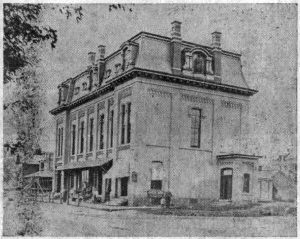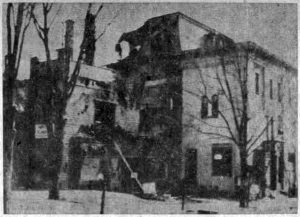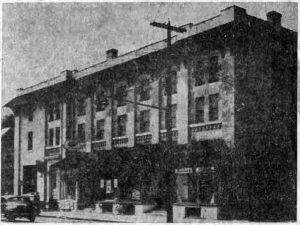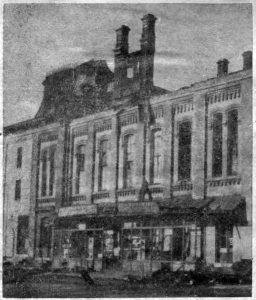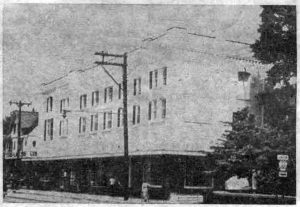Joseph Levis Worrall first attended the Old Eagle School in 1826, when he was nine years old. This was several years after Margaret Cornog, whose experiences in the school were related in last week’s column, went to classes there. Two of their teachers were the same, Adam Siter and George W. Lewis.
Two others whom Mr. Worrall recalled when he was writing his reminiscences in 1900 for “The Suburban” were Thomas Ward and Calvin James. After a year or two of early schooling he left, returning again in 1832 to remain for two years. This was when he was an apprentice in Philadelphia, and later at Mark Brooks’, near Radnor Station.
In April, 1839, he came to live in a house in Radnor, which his father had purchased from Edward Siter. Here he was still living some 61 years later, when he wrote his boyhood reminiscences.
By the time Joseph Worrall came to the school, there was an interesting innovation in the interior arrangement from the period when Margaret Cornog was a pupil there. This was a board partition through the school house, with the north end for the girls and the south end for the boys. The teacher sat in the girls’ end, close to the partition by the window without glass in it. Thus he could keep a sharp eye on the boys also.
“When we recited”, Mr Worrall writes, “we came through a door in the partition and lined up along the partition while we said our lessons, moving from tail to head as we answered right or wrong. We had as many as 70 girls and boys in the school, but not generally over 40. Among the pupils were a number of apprentice boys sent there by John Meredith, a builder in the neighborhood, at that time employing as many as 120 men at a time. In winter he has a sash and door factory close to where Lobb’s ‘board yard’ was later located.
“When I was first at the school there was nothing but the old open fireplace in the northwest side to heat the building. But it did well, though it was sometimes pretty cold across the partition in the boys’ end. Some complained, and some children were kept at home on that account in severe weather. But by making a hickory fire early, the building was generally quite comfortable.”
Until the school law came into effect, tuition for those whose families could afford it was $2 a quarter. This, however, did not include books, paper, or quills for pens. If, however, parents were too poor to pay for schooling, a justice of the peace could give a certificate to that effect. This was handed to the teacher when the child was admitted. The expense was charged to the director of the poor, who in turn charged that amount to the Township.
The first school trustees whom Mr. Worrall knew in his boyhood days were Edward Siter, “one of the Beavers”, Mifflin Lewis, Lewis Rush, John Ivester, John Pugh and John Meredith. When the committee met to consider Eagle School business, neighbors often joined them at the schoolhouse. “The lighting of the building at night was almost all done by candles. When we had debating and singing school, each of us would take a candle along. Some few occasionally took a sperm oil lamp. Edward Siter had one, as did some others.”
During the winter of 1832, a noteworthy event took place in the Eagle School, when an exhibition of the telegraph was given there one evening. Permission for the exhibition was obtained in advance from Edward Siter, who at that time was proprietor of the Spread Eagle Inn. The exhibition was to be a free one, the ultimate object of which was to obtain an appropriation from the Pennsylvania Legislature, if reports on the exhibition were favorable.
In order to spread the news of such an important event as this, Edward Siter went around on horseback to different stores, blacksmith shops and taverns with information about it. He also put a notice in the “Upland Union”, the Delaware County newspaper of which Alex McKeever was editor, and in the “Village Record”, Chester County’s publication.
When the eventful evening arrived the crowd was so large that many could not even get into the school building. “Dr. Joseph Blackfan and my father, Fred Worrall,” Mr Worrall writes, “were chosen by the people to sit by each telegraph operator, who took their positions at opposite corners of the room. Edward Siter, John Pugh and others stood in the door of the board partition as judges, to see that no sign was given of what was written, and then a message was sent across, the machine writing by dots and dashes on paper.
“Dr. Blackfan wrote down a message which his operator sent to the man at father’s end, who read it out loud, and then a message was sent back. The judges were first given the message Dr. Blackfan wrote down to see that no fraud was practiced. The message was always read off correctly, and the effect on the audience was astonishing. They carefully inquired of Dr. Blackfan and father to know if there was any collusion. Father and many others thought the exhibition was of supernatural powers. Edward Siter stated that he could not account for it. Others thought it was the work of the devil.
“The arrangements for the exhibition had been made with much care. The batteries were concealed in boxes. John Meredith sent men to do all the necessary carpenter work without charge. The school was dismissed at noon, so that they had the full afternoon for making their arrangements. The door was locked until the time of the exhibition.”
Whether the success of this meeting had the desired result of obtaining an appropriation from the Pennsylvania Legislature is not recorded in Mr. Worrall’s reminiscences. However, he does go on to say that, by special request, the exhibition was repeated at the schoolhouse at old Radnor Church, as well as at Friends Meeting School and at John Evans’ schoolhouse, south of Radnor Friends Meeting.
Another event of tremendous interest followed this meeting, when it was found that the Philadelphia and Columbia Railroad would lay its tracks almost within sight of the old Eagle School.
Many of the residents were ambitious to obtain better facilities for neighborhood meetings by erecting a large building on the school grounds “for scientific purposes”. A public meeting was held and much money was pledged for the proposed new meeting house. However, according to our historian, Joseph Worrall, “the influence of the Siter family, which was then very great, secured the improvement and erection of a hall down in Radnor, then called ‘The Radnor Scientific and Musical Fund Hall.’ Later this became the Radnor Baptist Church at the southwest corner of Wayne avenue and Old Lancaster road (Conestoga road), now the First Baptist Church.”
(The third and concluding article of this series on “Historical Notes” as they appeared in “The Suburban” in 1900 will be given next week, when Joseph Fisher Mullen’s reminiscences will be presented.)

